► Hot six-cylinder Merc driven
► An estate that sounds like a touring car
► And it’s not the pauper’s AMG
The King is dead. Long live the…prince? The underling? The underling, in this case, being the Mercedes-AMG E53. You see, the E53 was always a second-tier AMG E-Class; the supreme leader was always the E63. But – tissues at the ready – the E63 is, indeed, dead.
It is an ex-AMG, at least according to Mercedes’ big boss, Ola Källenius. He came straight out and said that V8 thunder in an E-Class no longer sits well with the brand’s shift towards hybrid and electrified powertrains. Mind you, Mercedes also announced the CLE 63 will have a V8 – presumably because dire sales of the four-pot C63 Hybrid has given Stuttgart’s head honchos the collywobbles. As always, everything should be taken with a pinch of salt.
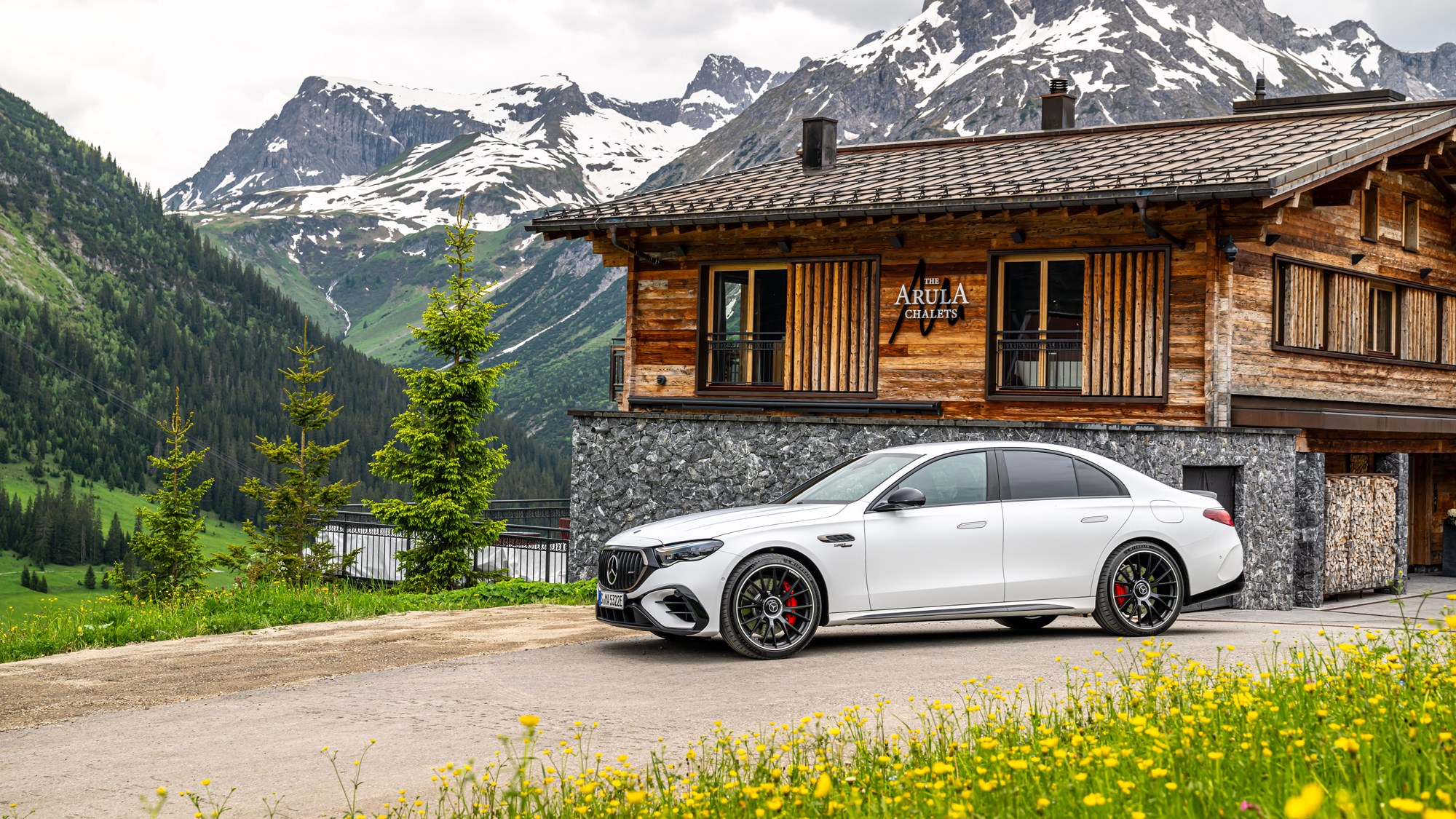
Anyway, taking what we’ve heard at face value, the new E53 Hybrid 4Matic+ is the king of E-Classes. And before the booing begins, this latest E53 is a much brawnier prospect than it was. Peak power is 604bhp, which matches the old E63 S, and should be enough to slug it out against the Audi RS6. And while that’s not a match for the forthcoming BMW M5, the latest E53, like the next M5, is a plug-in hybrid.
At a glance
Pros Beautiful ride, handling, performance, decent electric range, silky six-cylinder engine
Cons Price, heavier than the moon, gearbox is dodgy, lacks the sound of the V8
What’s new?
Not all of it. The MRA2 platform that underpins this and the regular E-Class has been kicking around since 2014. But uniquely the E53 gets a host of chassis strengthening – for example, the additional bracing between the front suspension turrets.
That’s not all. The E53 has wider tracks, stiffer suspension bushes, rear-wheel steering (it swivels up to 2.5 degrees) and Bilstein two-valve dampers. Interestingly, the springs are steel, not airbags.
The E53’s M256 3.0-litre turbocharged straight six isn’t new, either. It’s a development of the previous E53’s engine, but back then it was a mild hybrid. As we’ve mentioned, it’s now a full plug-in hybrid.
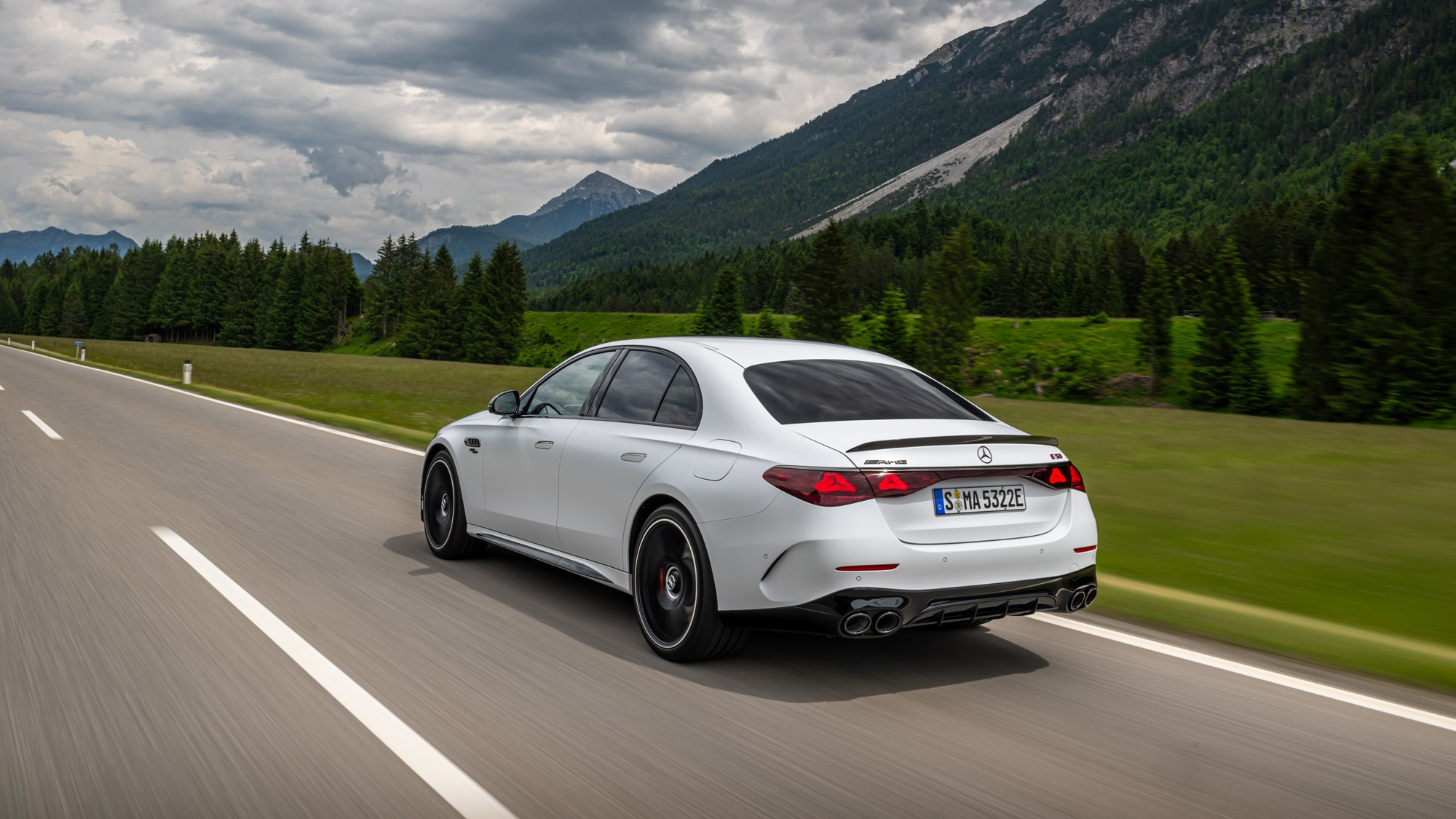
There’s 4Matic+ all-wheel drive with an electronically controlled centre differential. Theoretically, that can push 100 per cent of torque to either axle, but the engineers told us the front axle is always left energised a bit. That way it’s primed and ready to pull you out of a metaphorical hole – so you don’t make a real one, in a hedge.
The front and rear diffs are open. Unless you tick the box for the AMG Performance Package, in which case you get an electrically locking rear differential. If you’re feeling inclined, the AMG Performance Package is a £7,495 option on the Night Edition and standard on the Edition 1. It also adds Race Start (launch control), performance brake compounds, ups the top speed to 168mph (from 155mph), and fits a pair of fantastic AMG Performance front seats.
What are the specs?
Let’s begin with the good bits, and the straight-six bit is one of them. It produces 443bhp and 413lb ft of torque, but the synchronous motor sandwiched between the engine and the AMG Speedshift TCT 9G auto ‘box adds a further 161bhp and 354lb ft into the mix.
The consistent combined power figure is 577bhp, but that peaks at 604bhp if you have the Race Start programme fitted and initiated. As usual, it’s not simply a case of addition to get the total system torque. It’s 553lb ft, which is less than the old E63 S by 74lb ft. So why is the E53’s 0-62mph time of 3.8 seconds (that’s with max-attack Race Start; otherwise it’s 4.1 seconds) nearly half a second down on the old E63 S?
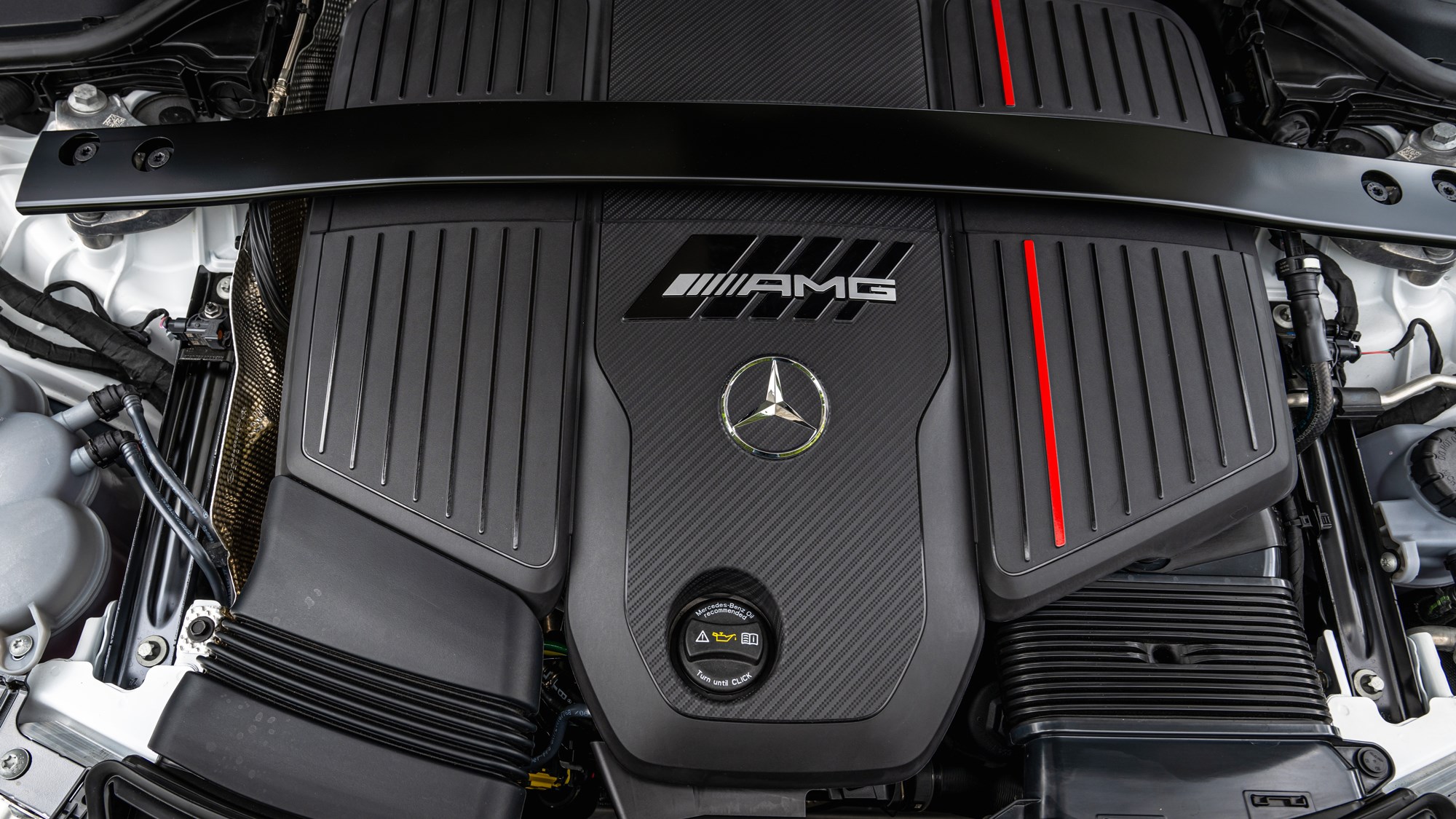
Well, that’s the bad bit: weight. The E53 weighs a mighty 2,390kg as a saloon and 2,435kg as a wagon. Wowzers.
Range & charging specs
The weight’s largely down to the 28.6kWh battery. That’s physically bigger than a standard E-Class PHEV’s but occupies the same space under the boot floor. One advantage of this is a better-balanced weight distribution: 47:53 front to rear.
The battery’s usable capacity is only 21.2kWh. Why? Because the E53 always maintains enough electrical reserve to deliver full performance whenever it’s needed. Even so, the official battery range is 59 miles, which is good. And it DC charges at 60kW, which is also good; you can cram a 10 to 80 per cent boost in about 20 minutes.
What’s it like to drive?
Lament the loss of that charismatic V8 all you like, but hear this: in a world of ever-further electrification, a lovely straight six is still something to celebrate. It really is a lovely engine, too. Well, it is when it’s not having bouts of synthesised flatulence, because if you stick the drive mode into Sport+ the noise is just bonkers.
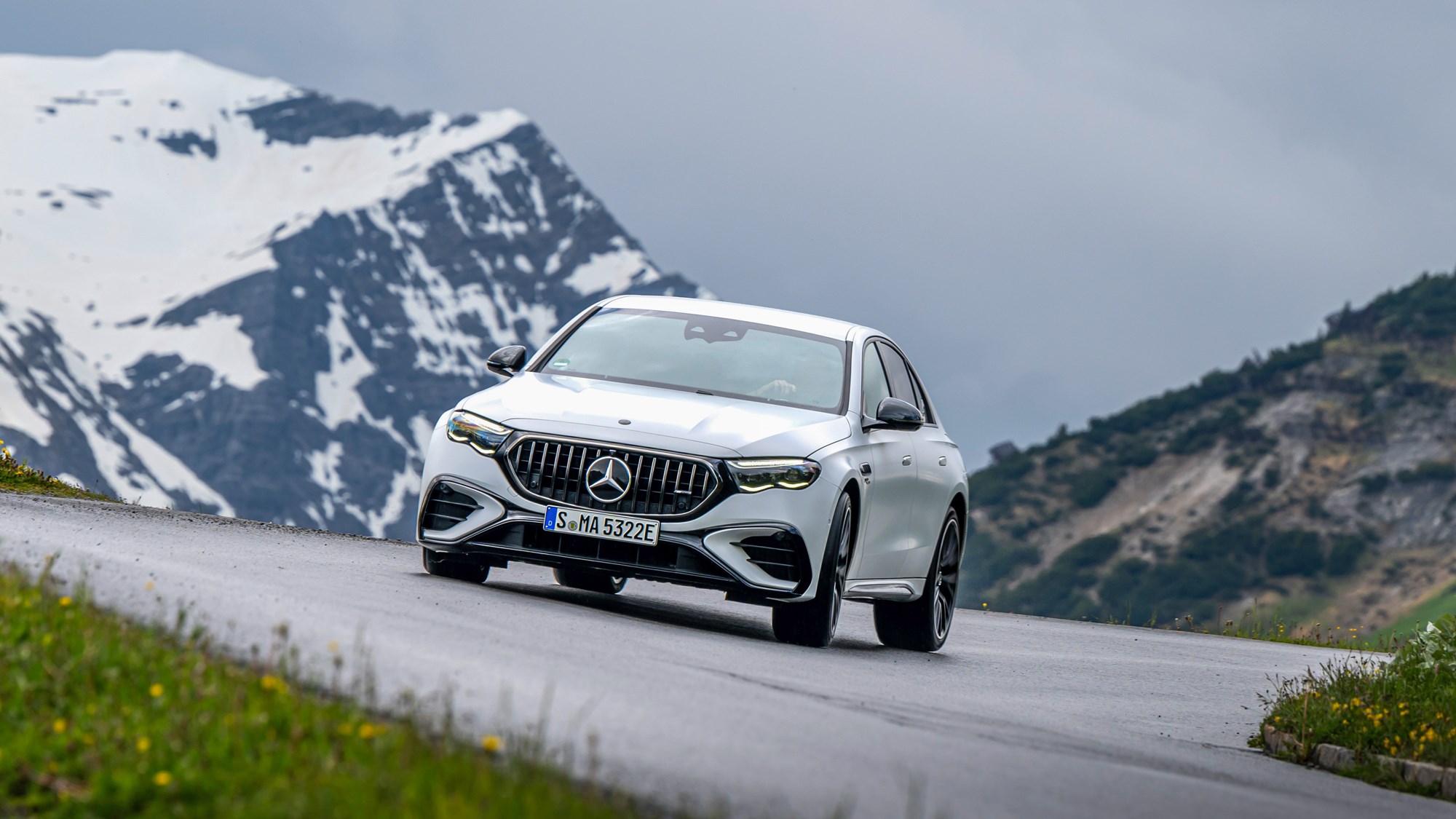
However, in Comfort mode or the Individual mode – where you can mix ‘n’ match the settings and turn the farty noises down – this engine produces a deliciously smooth, mechanical snarl. If you favour theatrics you’ll miss the magic and flamboyance of the V8, but if you appreciate good engineering this 3.0-litre has a resounding magic of its own. And let’s face it, the M3 went from straight six to V8 and back again, and few people felt cheated by that.
The power delivery is first-class. The E53 defaults to EV mode on start-up, which makes it very quiet, naturally. Like a TGV exiting a station, it glides seamlessly into motion and carries enough poke to hit motorway speeds, albeit steadily. The interesting part is when the petrol chimes in. Its peak torque sits between 2,200-5,000rpm but, of course, with great spoonfuls of electrical assistance plugging the blanks left by the turbocharger, the reservoir of torque feels prodigious.
It’s in no way spikey or overburdening, though. You can meter out the thrust perfectly with your right foot, and when you stamp hard on the accelerator from, say, 1,500rpm there’s some welcome progression: it builds gradually at first, with a step in urgency at around 4,500rpm, followed by a slight, if not exactly fulsome, flourish of power at the top end.
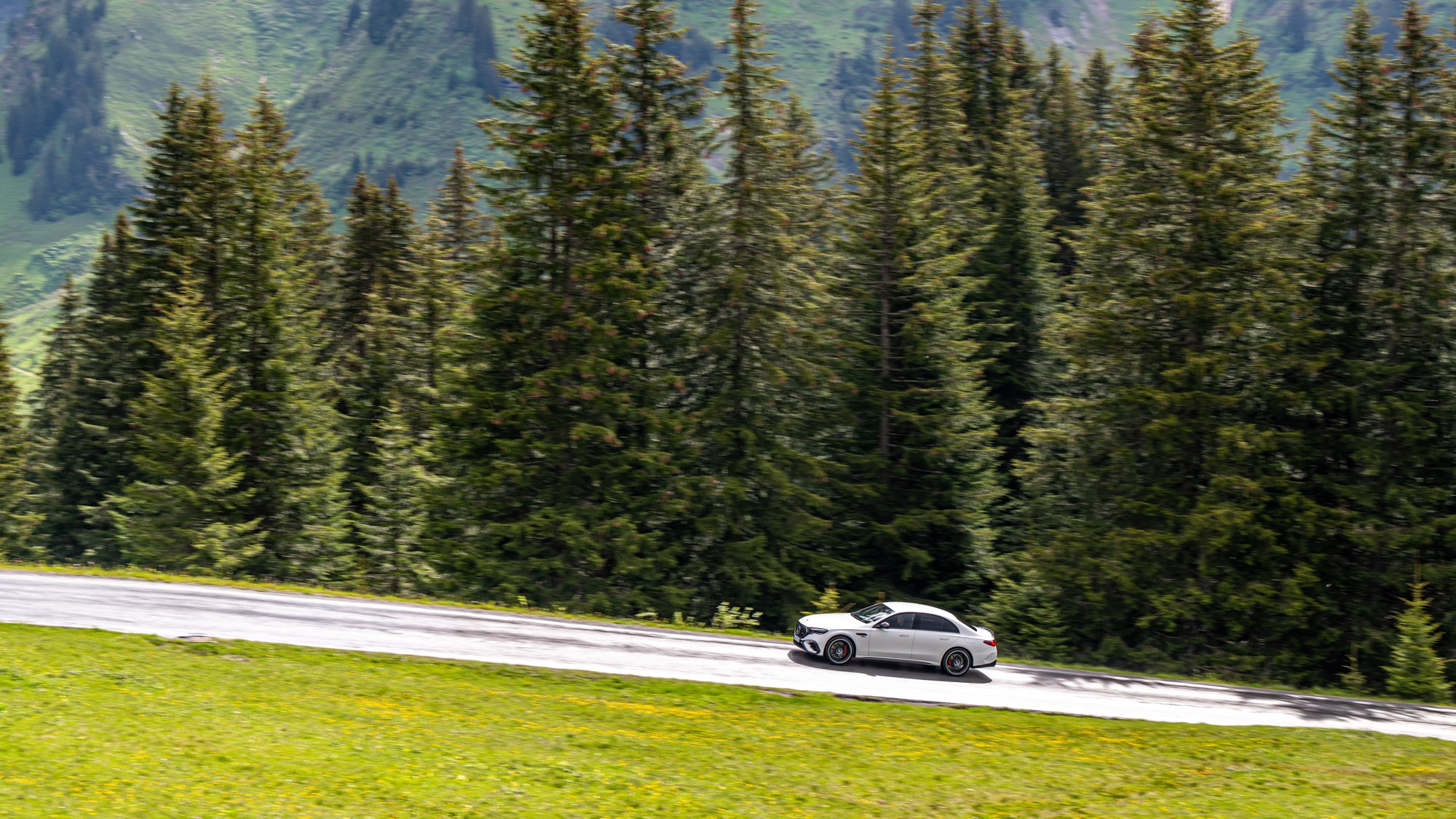
To go with the engine’s driveability there’s oodles of four-wheel-drive traction, too. But fear not: the old AMG magic is still there. Your friend and mine, Mr. Oversteer, is only ever an ESP-off away. And when the fun comes it’s easy to deal with, at least with the e-diff fitted to the cars we tried. For fun factor, then, the E53 has the RS6 pegged, but in terms of outright speed, maybe less so. But come on, any arguing over the last few percentiles of speed seems futile when this is plainly a beast in a straight line. Whether you’re firing it down short straights between corners or hoovering up the fast lane of an Autobahn, it’s unquestionably quick.
Speaking of corners, perhaps the most shocking thing is how well the E53 deals with them. Remember the weight: around 2.4 tonnes? Honestly, it feels much less when you’re sitting behind the wheel. Obviously, the rear-wheel steering helps. It gets the E53 turned in briskly, and you can sense the rotation at the rear through low-speed switchbacks. It’s not nervy, though, like some past AMGs. Perhaps there’s less surface feel through the steering column compared with the old E63, but I’d wager it’s more precise.
Then there’s the suspension. For a luxury car you might say it’s firm, but for a performance car it’s perfect. Literally. I can’t fault the ride. In Comfort it’s supple enough for rutted town roads; midway Sport is the dutiful all-rounder; Sport+ has all the control you need without feeling like a track-only option. There’s the occasional thud over a sharp ridge, which some people might comment is abrupt, but others will see it as a small trade-off for unwavering composure – find a fold in the road when the E53’s loaded up mid-bend and it simply doesn’t falter.
AMGs tend to suffer with more NVH transference than regular Mercedes, thanks in part to stiffer bushing and big old tyres. It’s the same here, but to a lesser degree than the previous E63. You can hear the suspension working and some roar from the (optional) 21-inch wheels, but it’s not outrageous. Meanwhile, wind noise is nicely subdued. In that sense, it feels closer to the RS6.
Even the brakes – normally a bugbear in hybrids – are good. Sure, they feel a little wooden at the top of the travel – rather like a car with no servo assistance – but you soon recalibrate
then think no more about it. One gripe is the gearbox: it’s slick in auto but could be more responsive when you’re pulling the paddles.
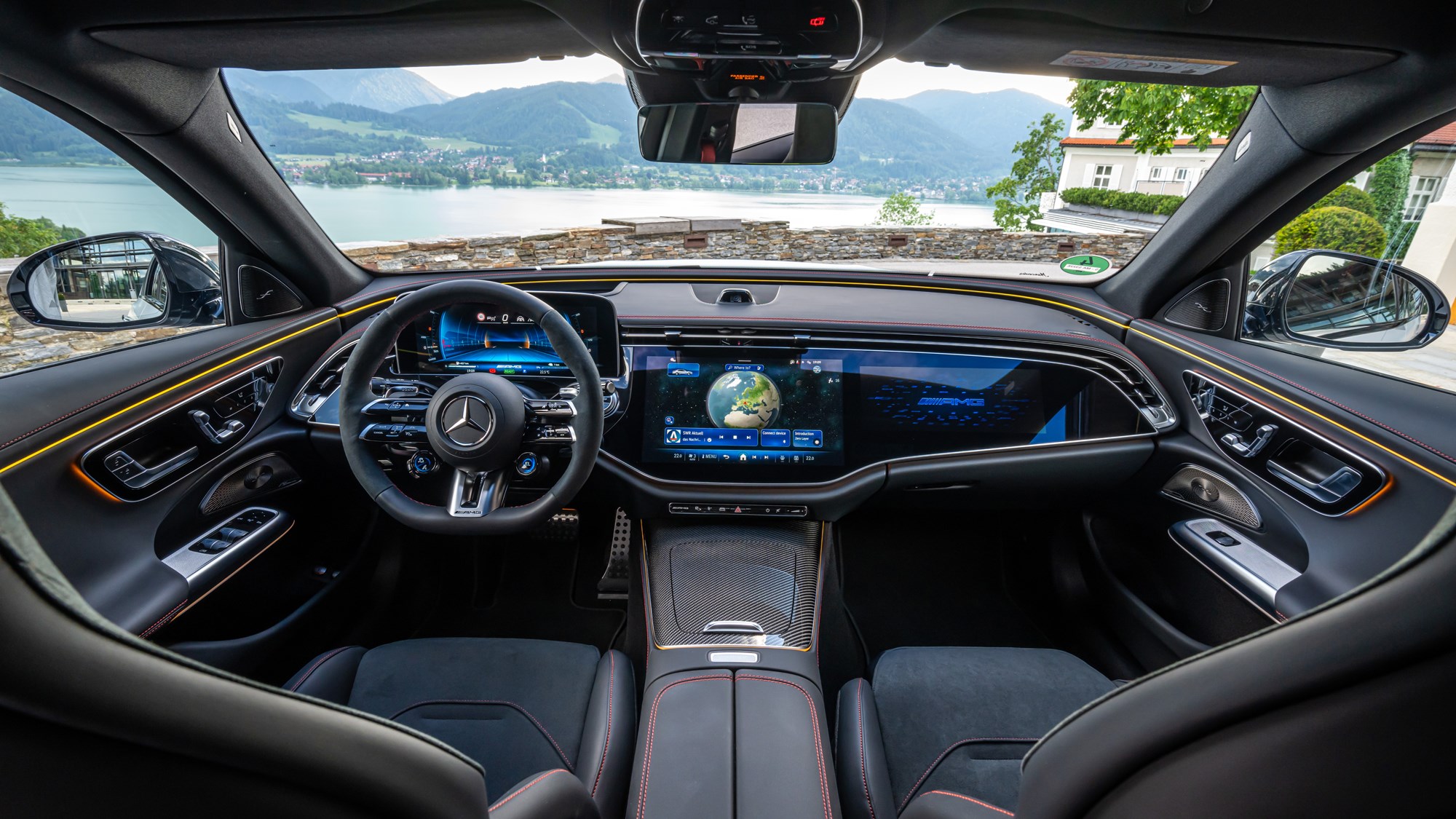
What about the interior?
Exactly like a current-gen E-Class’s, but with added AMG-ness. In the top-spec cars we drove that meant lots of leather, aluminium, satin chrome and shiny carbon fibre. Overall it feels well put together – certainly compared with some other recent Mercedes products – and looks expensive. Which it should, because with prices starting at £90,860 for the standard Premium saloon and rising to £118,110 for the most expensive estate in Edition 1 trim, it is very expensive.
With our German test cars in the bee’s-knees trim we got to try the AMG Performance front seats as well. They’re noteworthy: brilliant for long-distance comfort and cornering support. They add to a driving position that – in left-hand-drive guise – had no real flaws.
We also had the optional full Superscreen treatment that adds a passenger screen. As with the driver’s display and central infotainment screen, that too comes with AMG-specific software. The passenger can, for instance, see how fast you’re going, or try to forget how fast you’re going by watching YouTube instead, just like they can in a regular E-Class.
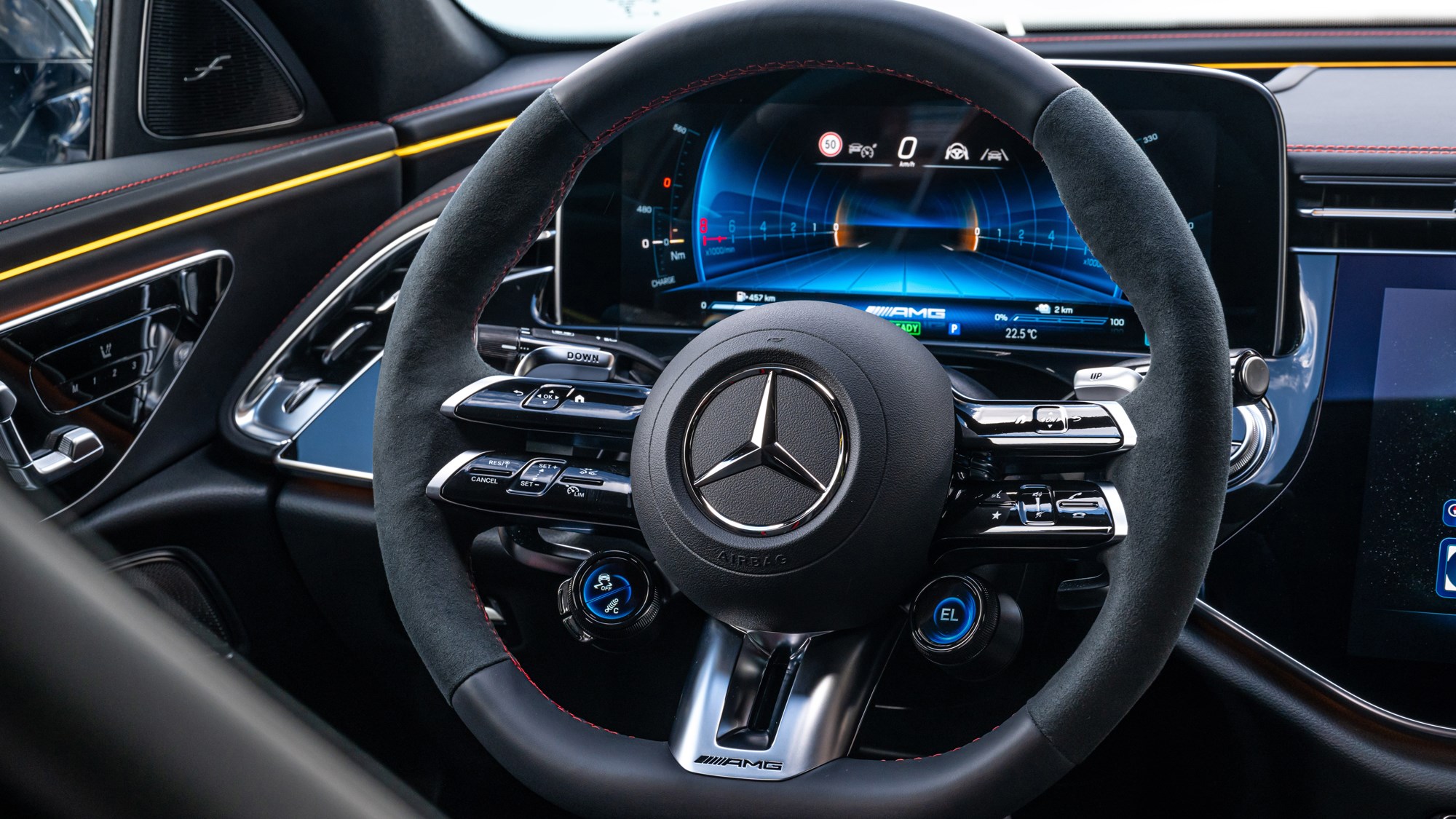
With so many distractions due to all those screens, fair play to AMG for providing a couple of useful shortcut buttons on the centre console – one to find the screen for turning off the annoying safety aids and another that gets you to the AMG drive modes. You’ve also got two rotary-and-push-to-select knobs on the steering wheel for quick mode changes, but the rest of the touch-sensitive steering wheel buttons are a joke. There are too many for a start, and you press them unintentionally too many times.
Even with the dimensionally bulky, semi-bucket front seats, you can still easily fit four six-feet-plus adults on board. The boot is the issue. Obviously, with a big battery under the floor, you lose a chunk of luggage space – down to 370 litres in the saloon and 460 litres in the estate. For context, a standard ICE E-Class saloon has 540 litres, while the estate has 615 litres. So if you’ve got a St. Bernard or a big wardrobe to shift any time soon, perhaps think about an RS6 Avant instead.
Verdict
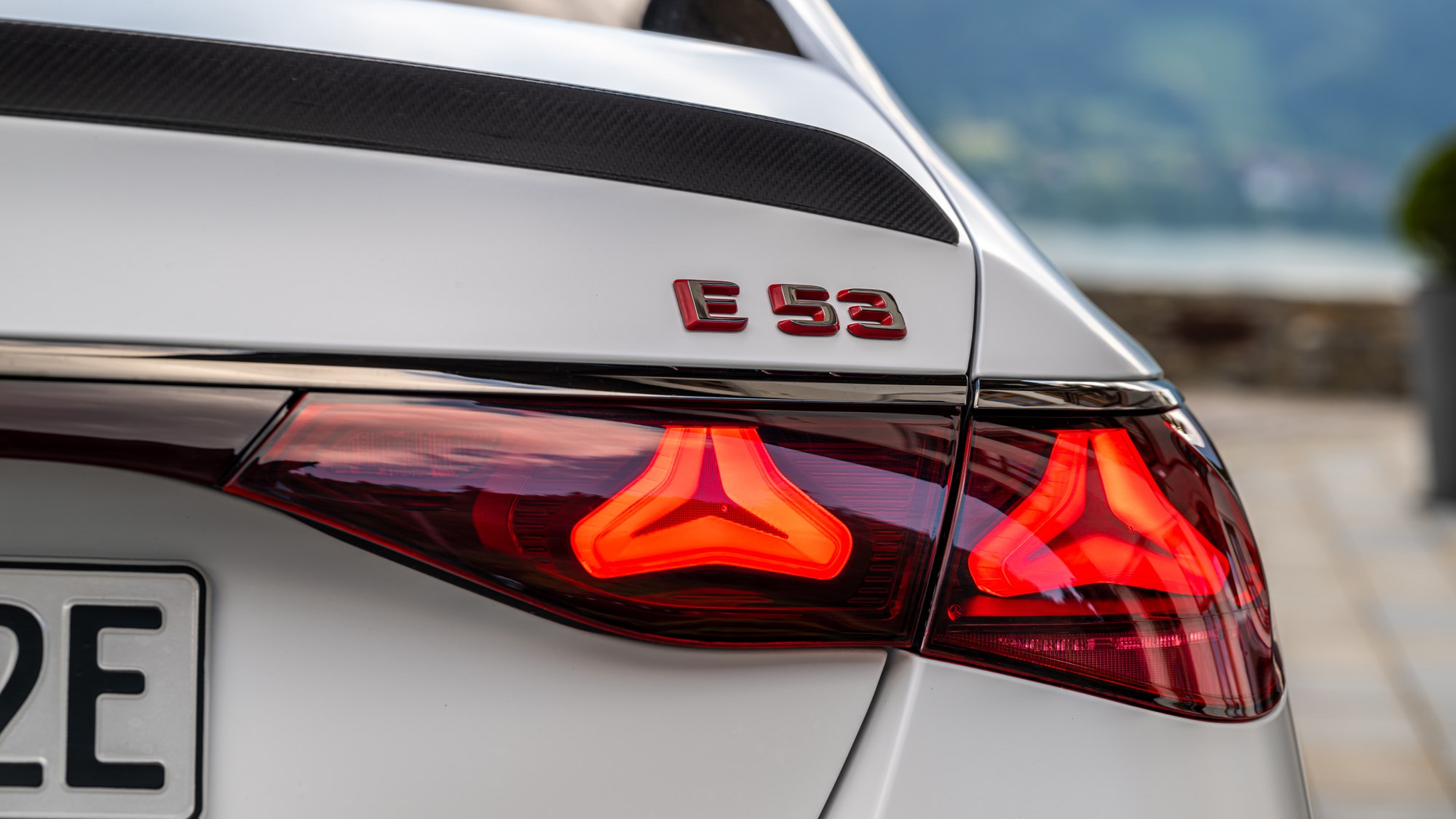
This could be one of the surprises of the year so far. Honestly, before driving the E53 expectations weren’t that high for two reasons: the two missing cylinders and it’s more massive than a neutron star. And let’s face it, the old E53, which was lighter, wasn’t the most exciting performance saloon in the world.
The new E53 isn’t raw and riotous like the old E63, but because it’s more refined and cosseting, it’s a better car to cross countries in – for once that’s not a trope, it’s what we did. And having a greater breadth of ability arguably brings it closer to rivals like the RS6 and M5. Of course, that greater breadth includes a useful electric range and seismically reduced BIK, should you fancy one as your next company car.
Crucially, though, on the road – and some very challenging roads at that – its combination of precision, poise and pace, plus a happy dose of tomfoolery, made for a thoroughly enjoyable drive. And the fact is, you barely notice the weight. It’s not quite at M3 or Giulia QV levels of driving pleasure, mainly because of its footprint, but given the keys to this or an RS6, I’d happily take the E53. It’s a different kind of fun compared with the E63, but it’s fun nonetheless. As we’ve said, the King is dead. Long live the Prince.